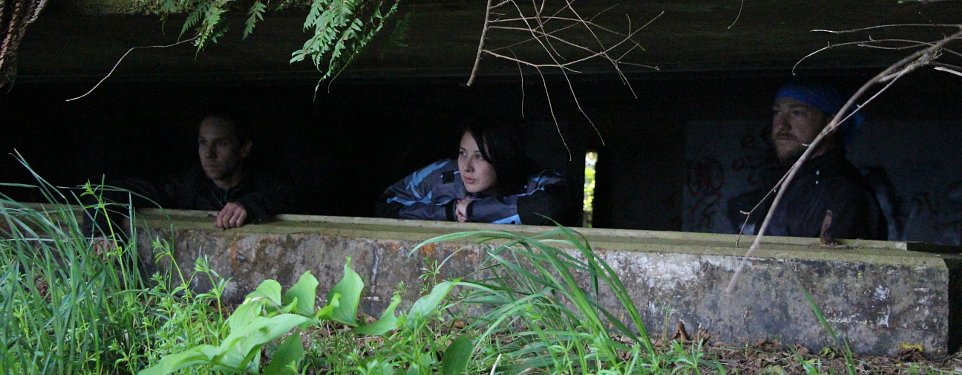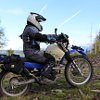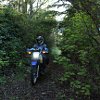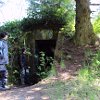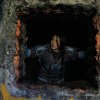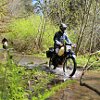It was a rigorous four-day excursion that started with an invitation: “Would you guys like to see something cool?”
Always.
Even better, that “something cool” can only be accessed by foot. Or by dual-sport motorcycle (cue happy face).
On a dreary April evening, Justin and I set out to Port Angeles, Wash., where our friends awaited us on their semi-off-the-grid, eight-acre compound that would be our base camp for this impending adventure. What were we looking for? American ruins. Forgotten fortresses swallowed by the Olympic Peninsula’s fiercely growing vegetation. Who needs to go to the jungles of Asia or South America to find the remnants of civilization? We found it in our very own backyard. Well, someone’s backyard.

Anyone who says riding motorcycles isn’t strenuous hasn’t ridden dirt. Or gravel. Or sand. Or mud. In the Northwest, mud, moss, wet leaves and grass are your main opponents. Since most of my Washington riding has been during summer’s drier months, the fickle spring weather was fussing with my confidence. And, I’ll admit, adding to the fun!

Nothing makes your arms ache, back sore, and butt clench like sliding over bumps, stumps and baby-head rocks down single-track. Or, breaking loose across rutted gravel roads at speed. Then, add a sheer drop on either side. Blasting through puddles, blind to their depths, was the most fun and, sometimes, the most sketchy (face contorts from ecstatic to anxious and back again). There was a moment I had to choose between opening my faceshield so as to see past my own breath's fog or closing it so as not to be slapped in the face by branches.

The first day, I saw my heart pounding through my riding jacket. By the fourth day, it was merely a faint reminder that control and security are ever fleeting.
Confidence welled up in me whenever I’d overcome an obstacle that had stopped me dead in my tracks (or knocked me on my ass) two days before.

The destinations of this ride were those American ruins. As threats loomed during World War II, the government spent millions to build defenses along the entrance to Puget Sound. The largest and most visited of these bunkers are at Camp Hayden. "Before war’s end, the Camp Hayden military reservation concealed two heavily camouflaged, bomb-proof, two-gun batteries: one 6-inch installation 2,000 feet up Striped Peak and a 16-inch battery on Tongue Point. The guns were test-fired only once," notes the Clallam County Parks site.
Our prizes were more hidden from sight and less accessible than those at Camp Hayden. During the last leg of our journey, the most challenging ride to the most stupendous of bunker sites (and we had seen many that week) we traveled far off the beaten path. It was the most difficult ride I’ve experienced.

Compared to the rest, this fortress was unassuming. The smallest, but the brightest. It sat at the edge of a monstrous bluff, at the top of a twisty, steep, muddy mountain track. Reaching it was like being rewarded with well-earned treat. Relieved to dismount and let my pulse settle, I hardly noticed the modest ruin, at first.
It felt as if there were a subtle buzzing around it. Perhaps energy left behind by the hundreds (if not more) of people who’ve walked between its walls. A piece of history now, forged long ago and consigned to oblivion by its builders.

I was in awe. We’d been waiting days to find this unglamorous cement room. And now that we were there, it had all been worth it. The obstacles. The crashes. The heat.

All of us bellied up to the wide rectangular opening opposite the doorway and stared silently for a while. Maybe fatigue was setting in. Or maybe the sight of something that beautiful, that much greater, managed to capture the attention of four young and restless adventure riders. So, we let it.

When it was all said and done, we drifted slowly out of the cool, noiseless room in a lull. A place neglected but still commemorated. A safe haven for weary adventurers and treasure for creatives with a big imagination. Turning my bike around, firing it back up, and grateful the long day was over, my heart picked up its pace, remembering something before I did.
Oh, yeah. Now I have to ride back down the mountain.































 Riders Preferred Membership
Riders Preferred Membership
